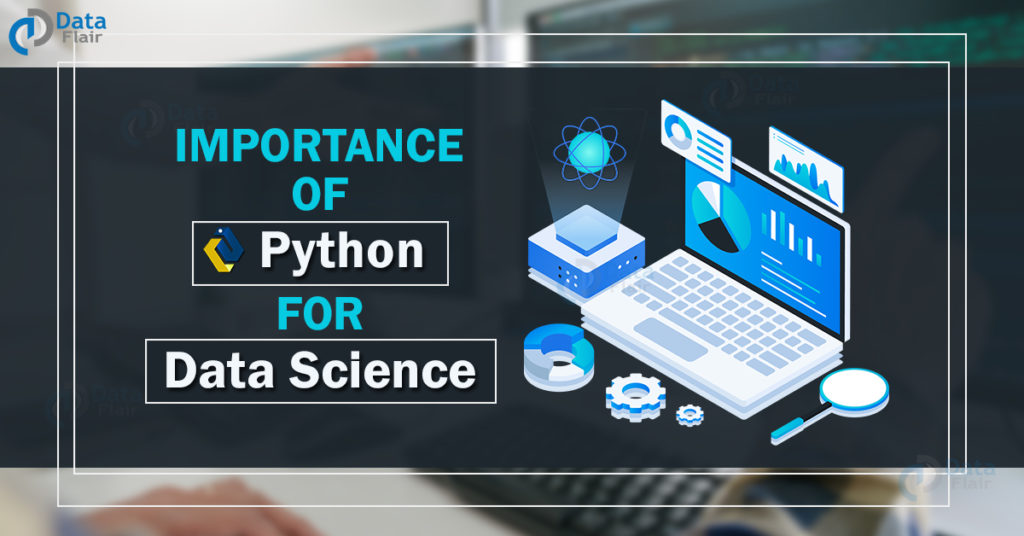As more opportunities open up in data science, one can notice a common skill that all data science roles require – the knowledge of python.
The language has almost become synonymous with data analysis.
So, why is it so important to know Python if one wants a career in data science?
Keeping you updated with latest technology trends
Follow DataFlair on Google News
Python – A Brief Introduction
Python is a high-level general-purpose programming language. It has a simple syntax and code readability. Thus, one can get accustomed to coding in Python in no time.
In Python, there is no compilation step. It follows an edit-test-debug process which makes coding quick and easy to maintain. Coding in Python is highly productive as well.
Python for Data Science
Python is a general-purpose programming language.
It is useful for web development, report generation, simulation and a host of other applications.
Today, it has become a favorite tool of data scientists worldwide. How does it find application in data science?
1. Gathering data
Sometimes, it so happens that the data we need has to be collected from various sources on the web.
Python has the libraries Python Scrapy and BeautifulSoup specially to extract data from the internet.
2. Data cleaning and preprocessing
Once the data collection process is over, the data is ready. But large datasets in real life applications usually have noise – missing values, incorrect values in categorical columns, invalid values and so on.
Python has functions to identify such values and eliminate noise. Thus, Python is useful in cleaning large datasets.
3. Data visualization
While dealing with large amounts of data, it is essential to have some visualization tools. Visualization is the mapping of data points to space.
A visual representation helps in easy identification of trends, outliers and other patterns which can influence some strategic decisions.
Python libraries like Matplotlib and Seaborn offer a huge variety of tools to visually represent data. It is easy to carry out exploratory data analysis using Python libraries and methods.
4. Training a model
The next stage of data analysis is building an appropriate machine learning model for a dataset. Python provides implementation for plenty of machine learning models.
There are algorithms to train all kinds of problems – classification, regression, clustering, image recognition and many more.
Thus, it is evident that Python libraries are of use in almost every step of data analysis. Hence, Python is the most preferred language in data science.
Commonly Used Python Libraries for Data Science
Below are some of the commonly used Python libraries.
1. Pandas
Pandas is an open-source library that is especially useful to clean, preprocess and analyze tabular data.
It has two kinds of data structures – data frame for two-dimensional data and series for one-dimensional data.
Pandas contains methods to read tabular data, calculate summary statistics for data, combine data from tables, manipulate textual data and perform many more operations.
2. Numpy
Numpy stands for Numerical Python. The library is primarily used while working with arrays.
Numpy provides methods required for linear algebra, matrix manipulations and Fourier transformation.
For large single and multi-dimensional arrays, Numpy is the best library.
3. Scikit-learn
Scikit-learn is the go-to library to implement machine learning algorithms on datasets.
It provides all the functions necessary to apply models such as linear regression, logistic regression, decision tree, random forest, SVM and many such algorithms.
4. Seaborn
Seaborn is a popular data visualization library. From simple graphs and pie charts to heatmaps and kde plots, it is possible to implement all kinds of visualizations using methods in seaborn.
Graphs created using this library and insightful and visually attractive.
Benefits of using Python for Data Science
Python offers several benefits over other data analysis tools.
Here are the top advantages that make the language a popular choice among data scientists.
1. The global community
Getting stuck in the middle of a project is something every programmer faces. However, with Python, there is no need to worry.
Thanks to the growing number of Python developers and data scientists worldwide, there are plenty of platforms to seek help from the community.
Coding and debugging in Python becomes much simpler with guidance from the worldwide community.
2. Simplicity
Most programming languages have a steep learning curve.
It can be weeks or months before a novice programmer can start working on their first project. That is not the case with Python.
The simple syntax coupled with relatively lesser lines of code make it an ideal language.
3. Open Source Language
It is an open-source language. Thus, data scientists can install the language and its popular libraries on their devices for free.
Summary
Python serves as a versatile language with a million possibilities. With its open-sources libraries, numerous useful packages, a low learning curve, and an enthusiastic developer community, data scientists find it easy to use Python for data analysis.
